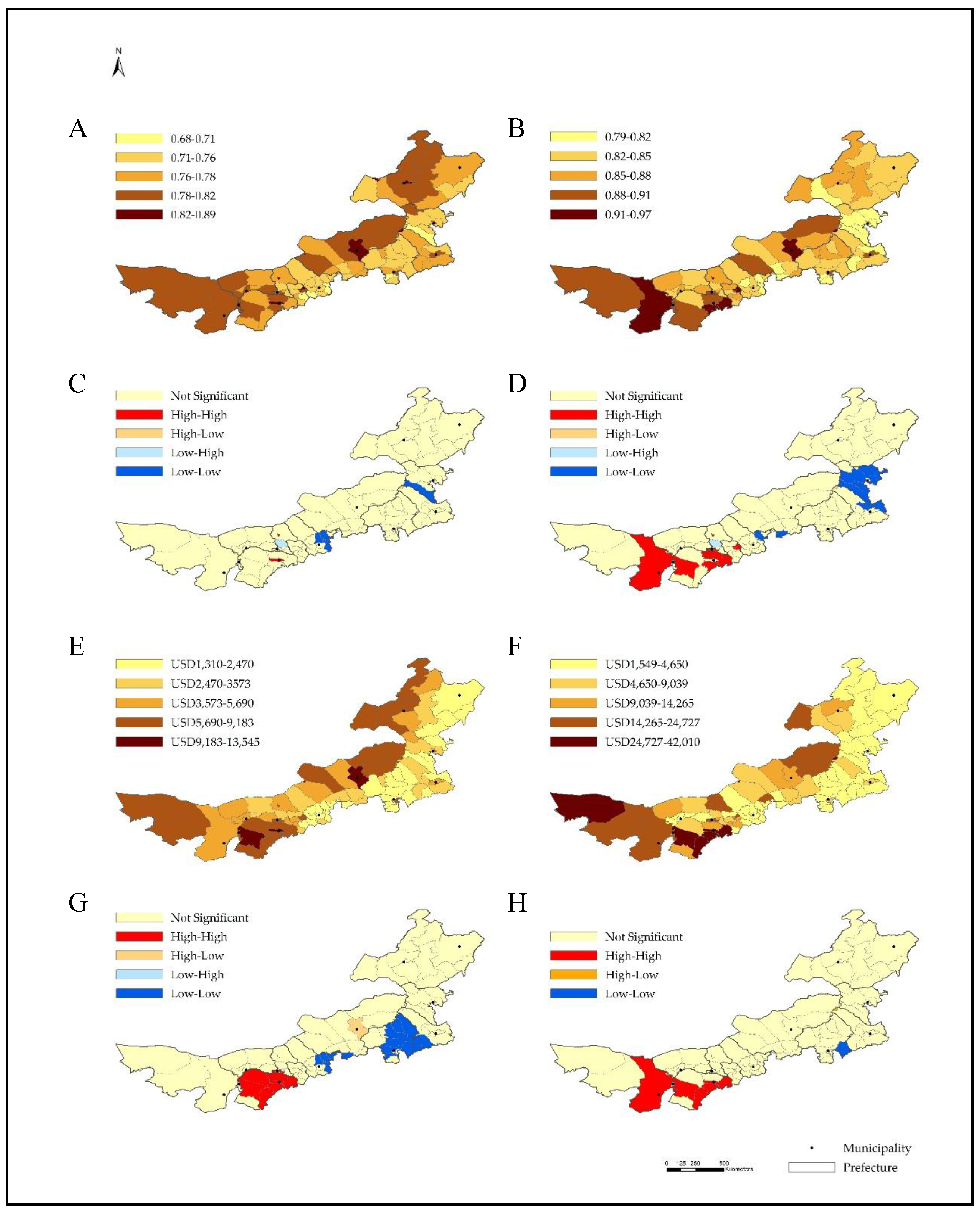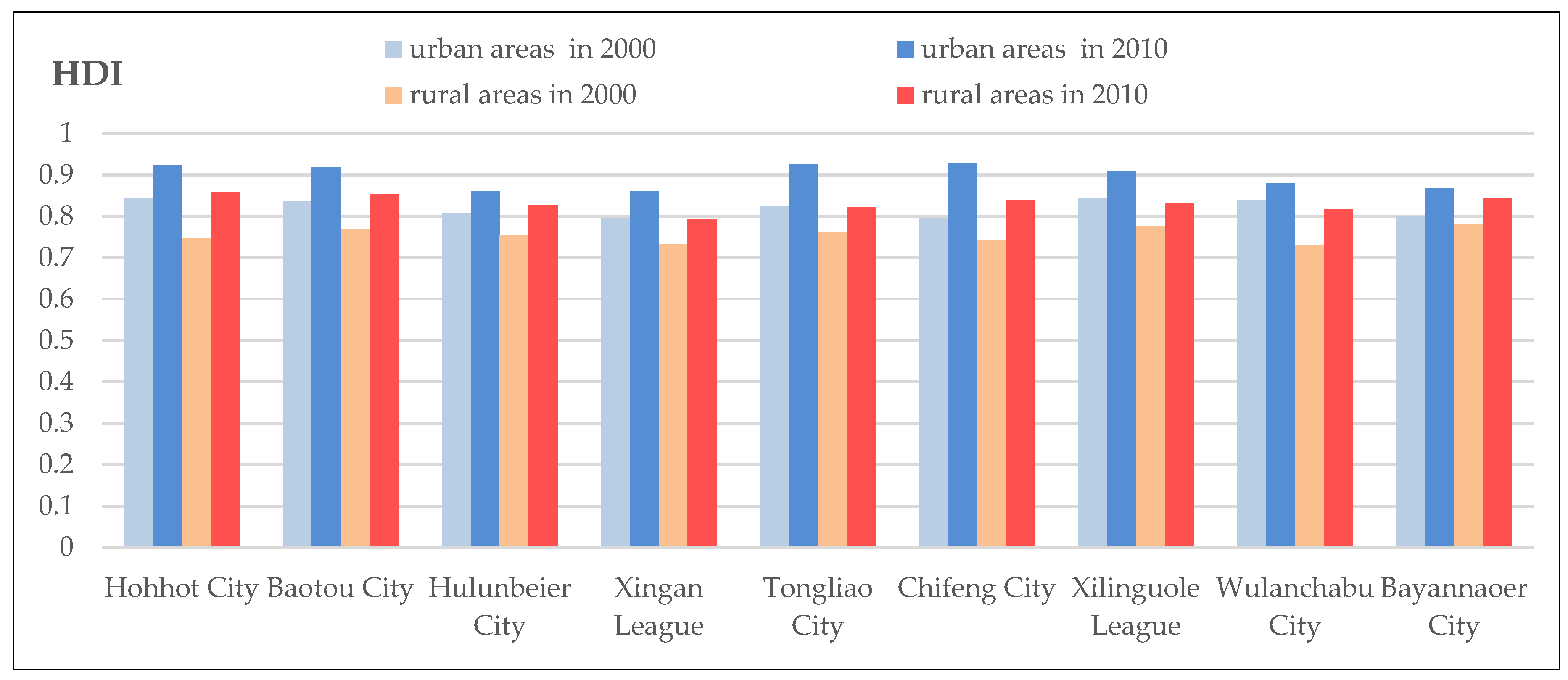Urbanization and Socioeconomic Development in Inner Mongolia in 2000 and 2010: A GIS Analysis
Abstract
:1. Introduction
2. Methods
2.1. Study Area
2.2. Measures
2.3. HDI Calculation
2.4. Statistical Analyses
3. Results
3.1. Temporal and Spatial Patterns of HDI and GDP in 2000 and 2010
3.2. Comparing HDI and GDP
3.3. Urbanization, GDP and HDI
4. Discussion
5. Conclusions
Acknowledgments
Author Contributions
Conflicts of Interest
References
- Dasgupta, P. Human Well-Being and the Natural Environment; Oxford University Press: Oxford, UK, 2001. [Google Scholar]
- Abramovitz, M.; Inkeles, A. Economic growth and its discontents. Bull. Am. Acad. Arts Sci. 1973, 27, 11–27. [Google Scholar] [CrossRef]
- Layard, R. Happiness: Lessons form a New Science; Penguin Press: London, UK, 2005. [Google Scholar]
- Forgeard, M.J.C.; Jayawickreme, E.; Kern, M.L.; Seligman, M.E.P. Doing the right thing: Measuring wellbeing for public policy. Int. J. Wellbeing 2011, 1, 79–106. [Google Scholar]
- Morris, D.; McAlpin, M. Measuring the Condition of the World’s Poor; Pergamons Press: Oxford, UK, 1979; pp. 20–40. [Google Scholar]
- Bradburn, N. The Structure of Psychological Well-Being; Aldine: Chicago, IL, USA, 1969; pp. 252–253. [Google Scholar]
- Diener, E.; Emmons, R.A.; Larsen, R.J.; Griffin, S. The satisfaction with life scale. J. Personal. Assess. 1985, 49, 71–75. [Google Scholar] [CrossRef] [PubMed]
- Marks, N.; Abdallah, S.; Simms, A.; Thompson, S. The Happy Planet Index; New Economics Foundation: London, UK, 2006; pp. 10–14. [Google Scholar]
- Vazquez, C.; Hervas, G. Addressing current challenges in cross-cultural measurement of well-being: The pemberton happiness index. In Well-Being and Culture: Perspectives from Positive Psychology; Springer: Dutch, The Netherlands, 2013; Volume 3, pp. 31–49. [Google Scholar]
- United Nations Development Programme (UNDP). Human Development Report 1990: Concept and Measurement of Human Development; Oxford University Press: New York, NY, USA, 1990. [Google Scholar]
- Sen, A. Development as Freedom; Oxford University Press: Oxford, UK, 2001; pp. 22–24. [Google Scholar]
- Ul Haq, M. The birth of the human development index. In Readings in Human Development; Oxford University Press: Oxford, UK, 2003; Volume 2, pp. 127–137. [Google Scholar]
- United Nations Development Programme (UNDP). Human Development Report 2015: Work for Human Development; UNDP: New York, NY, USA, 2015. [Google Scholar]
- Desai, M. Human development: Concept and measurement. Eur. Econ. Rev. 1991, 35, 350–357. [Google Scholar] [CrossRef]
- Sagar, A.D.; Najam, A. The human development index: A critical review 1. Ecol. Econ. 1998, 25, 249–264. [Google Scholar] [CrossRef]
- Stanton, E. The Human Development Index: A History. Working Papers. 2007. Available online: http://scholarworks.umass.edu/peri_workingpapers/85/ (accessed on 28 November 2016).
- Pinar, M.; Stengos, T.; Yazgan, M.E. Measuring human development in the mena region. Emerg. Mark. Financ. Trade 2015, 51, 1179–1192. [Google Scholar] [CrossRef]
- Sharma, K. Human development and South East Asian countries: Special emphasis on India. J. Educ. Health Promot. 2013, 2, 45. [Google Scholar] [CrossRef] [PubMed]
- Türe, C. A methodology to analyse the relations of ecological footprint corresponding with human development index: Eco-sustainable human development index. Int. J. Sustain. Dev. World Ecol. 2013, 20, 9–19. [Google Scholar] [CrossRef]
- Blancard, S.; Hoarau, J.F. A new sustainable human development indicator for small island developing states: A reappraisal from data envelopment analysis. Econ. Model. 2013, 30, 623–635. [Google Scholar] [CrossRef]
- Wu, S.H.; Woo, J.; Zhang, X.H. Worldwide socioeconomic status and stroke mortality: An ecological study. Int. J. Equity Health 2013, 12, 1–11. [Google Scholar] [CrossRef] [PubMed]
- Ghoncheh, M.; Mirzaei, M.; Salehiniya, H. Incidence and mortality of breast cancer and their relationship with the human development index (HDI) in the world in 2012. Asian Pac. J. Cancer Prev. 2015, 16, 8439–8443. [Google Scholar] [CrossRef] [PubMed]
- Ghoncheh, M.; Mohammadian-Hafshejani, A.; Salehiniya, H. Incidence and mortality of breast cancer and their relationship to development in Asia. Asian Pac. J. Cancer Prev. 2015, 16, 6081–6087. [Google Scholar] [CrossRef] [PubMed]
- Lacey, C.J. Global burden of human papillomavirus and related diseases. Vaccine 2012, 30 (Suppl. 5), F12–F23. [Google Scholar]
- Hu, Q.D.; Zhang, Q.; Chen, W.; Bai, X.L.; Liang, T.B. Human development index is associated with mortality-to-incidence ratios of gastrointestinal cancers. World J. Gastroenterol. 2013, 19, 5261–5270. [Google Scholar] [CrossRef] [PubMed]
- Rodríguez-Morales, A.J.; Castañeda-Hernández, D.M. Relationships between morbidity and mortality from tuberculosis and the human development index (HDI) in Venezuela, 1998–2008. Int. J. Infect. Dis. 2012, 16, e704–e705. [Google Scholar] [CrossRef] [PubMed]
- Salazar Silva, F.; Villatoro Velazquez, J.A.; Oliva Robles, N.F.; Hynes, M.; de Marco, M. Relationship between human development and drug use. Human development index and drug use. Salud Ment. 2014, 37, 35–39. [Google Scholar] [CrossRef]
- Roy, A.; Roe, M.T.; Neely, M.L.; Cyr, D.D.; Zamoryakhin, D.; Fox, K.A.; White, H.D.; Armstrong, P.W.; Ohman, E.M.; Prabhakaran, D. Impact of human development index on the profile and outcomes of patients with acute coronary syndrome. Heart 2015, 101, 279–286. [Google Scholar] [CrossRef] [PubMed]
- Dutra, F.; Rodrigues, P.; Fialho, E.; Lannes, D.; Atella, G. Education and globalization: A research of food consumption and obesity with children from low and high human development index areas. In Proceedings of the 5th International Conference of Education, Research and Innovation (ICERI), Madrid, Spain, 19–21 November 2012; Chova, L.G., Martinez, A.L., Torres, I.C., Eds.; International Technology, Education and Development (INTED): Valencia, Spain, 2012; pp. 1602–1606. [Google Scholar]
- Lee, A.Y.; Pridmore, S. Emerging correlations between measures of population well-being, suicide and homicide: A look at global and Australian data. Aust. Psychiatry 2014, 22, 112–117. [Google Scholar] [CrossRef] [PubMed]
- Dumith, S.C.; Hallal, P.C.; Reis, R.S.; Rd, K.H. Worldwide prevalence of physical inactivity and its association with human development index in 76 countries. Prev. Med. 2011, 53, 24–28. [Google Scholar] [CrossRef] [PubMed]
- Kusharjanto, H.; Kim, D. Infrastructure and human development: The case of Java, Indonesia. J. Asia Pac. Econ. 2011, 16, 111–124. [Google Scholar] [CrossRef]
- Amador-Jimenez, L.; Willis, C.J. Demonstrating a correlation between infrastructure and national development. In. J. Sustain. Dev. World Ecol. 2011, 19, 197–202. [Google Scholar] [CrossRef]
- Harttgen, K.; Vollmer, S. A reversal in the relationship of human development with fertility? Demography 2014, 51, 173–184. [Google Scholar] [CrossRef] [PubMed]
- Gaygısız, E. How are cultural dimensions and governance quality related to socioeconomic development? J. Socio-Econ. 2013, 47, 170–179. [Google Scholar] [CrossRef]
- Schmitt, J.V.; Miot, H.A. Distribution of brazilian dermatologists according to geographic location, population and hdi of municipalities: An ecological study. An. Bras. Dermatol. 2014, 89, 1013–1015. [Google Scholar] [CrossRef] [PubMed]
- Pinheiro, A.C.; Niederauer, J.M.; Vargas, D.M. Secular trend of growth in stature in Florianopolis in the state of Santa Catarina (Brazil) in relation with the human development index (HDI). Cien Saude Colet 2014, 19, 227–233. [Google Scholar] [CrossRef] [PubMed]
- Permanyer, I. Using census data to explore the spatial distribution of human development. World Dev. 2013, 46, 1–13. [Google Scholar] [CrossRef]
- Silva, R.; Ferreira-Lopes, A. A regional development index for portugal. Soc. Indic. Res. 2014, 118, 1055–1085. [Google Scholar] [CrossRef]
- Batty, M. The New Science of Cities; MIT Press: Cambridge, MA, USA, 2013. [Google Scholar]
- Inner Mongolia Autonomous Region Bureau of Statistics. Inner Mongolia Statistical Yearbooks 2015; China Statistic Press: Beijing, China, 2015. (In Chinese) [Google Scholar]
- Inner Mongolia Autonomous Region Bureau of Statistics. Inner Mongolia Statistical Yearbooks 2011; China Statistic Press: Beijing, China, 2011. (In Chinese) [Google Scholar]
- National Bureau of Statistics of the People’s Public of China. China Statistical Yearbooks 2011; China Statistic Press: Beijing, China, 2011. (In Chinese)
- Office for the Sixth Population Census of Inner Mongolia Autonomous Region; Inner Mongolia Autonomous Region Bureau of Statistics. Tabulation on the 2010 Population Census of Inner Mongolia Autonomous Region; China Statistic Press: Beijing, China, 2012. (In Chinese) [Google Scholar]
- Population Census Office under the State Council; Department of Population and Employment Statistics National Bureau of Statistics. Tabulation on the 2010 Population Census of the People’s Republic of China; China Statistic Press: Beijing, China, 2012. (In Chinese)
- Inner Mongolia Autonomous Region Bureau of Statisitcs. Inner Mongolia Statistical Yearbooks 2001; China Statistic Press: Beijing, China, 2001. (In Chinese) [Google Scholar]
- Office for the Fifth Population Census of Inner Mongolia Autonomous Region; Inner Mongolia Autonomous Region Bureau of Statistics. Tabulation on the 2000 Population Census of Inner Mongolia Autonomous Region; China Statistic Press: Beijing, China, 2002. (In Chinese) [Google Scholar]
- Zha, R.C. Life Expectancy Table. Popul. Res. 1981, 5, 55–61. (In Chinese) [Google Scholar]
- United Nations Development Programme (UNDP). Human Development Report 2010. The Real Wealth of Nations: Pathways to Human Development; Palgrave Macmillan: New York, NY, USA, 2010; p. 15. [Google Scholar]
- Environmental Systems Research Institute (ESRI). ArcGIS Desktop: Release 10; Environmental Systems Research Institute: Redlands, CA, USA, 2011. [Google Scholar]
- Wu, X.D.; Wang, C.Z. County-level economy development model in Inner Mongolia. J. Inner Mong. Norm. Univ. (Philos. Soc. Sci.) 2009, 38, 89–94. (In Chinese) [Google Scholar]
- Jiang, Y.Z. The theoretical thoughts of economic development mode in Inner Mongolia. North. Econ. 2009, 1, 22–23. Available online: http://www.cnki.com.cn/Article/CJFDTotal-BFJJ200901009.htm (accessed on 28 November 2016). (In Chinese)[Google Scholar]


| Indicators | Measure | |
|---|---|---|
| Income | GDP per capita | |
| Health | Life expectancy | |
| Education | Adult Literacy | Proportion 15 and older with literacy |
| Gross Enrolment | Proportion 5–19 year-old population of primary and secondary students |
| More Favorable HDI Rank | Less Favorable HDI Rank | ||
|---|---|---|---|
| Year 2000 | Year 2000 | ||
| Hongshan District in Chifeng City | +40 | Xinbaerhuyou Banner in Hulunbeier City | −50 |
| Genhe City in Hulunbeier City | +30 | Hangjin Banner in Erdos City | −37 |
| Wushen Banner in Erdos City | −34 | ||
| Zhungeer Banner in Erdos City | −33 | ||
| Dongwuzhumuqin Banner in Xilinguole League | −32 | ||
| Tumotezuo Banner in Hohhot City | −31 | ||
| Xinbaerhuzuo Banner in Hulunbeier City | −30 | ||
| Year 2010 | Year 2010 | ||
| Linxi County in Chifeng City | +43 | Xinbaerhuzuo Banner in Hulunbeier City | −50 |
| Hongshan District in Chifeng City | +41 | Sunitezuo Banner in Xilinguole League | −41 |
| Jining District in Wulanchabu City | +38 | Xinbaerhuyou Banner in Hulunbeier City | −38 |
| Balinyou Banner in Chifeng City | +34 | Xiwuzhumuqin Banner in Xilinguole League | −37 |
© 2017 by the authors. Licensee MDPI, Basel, Switzerland. This article is an open access article distributed under the terms and conditions of the Creative Commons Attribution (CC BY) license ( http://creativecommons.org/licenses/by/4.0/).
Share and Cite
Huang, G.; Jiang, Y. Urbanization and Socioeconomic Development in Inner Mongolia in 2000 and 2010: A GIS Analysis. Sustainability 2017, 9, 235. https://doi.org/10.3390/su9020235
Huang G, Jiang Y. Urbanization and Socioeconomic Development in Inner Mongolia in 2000 and 2010: A GIS Analysis. Sustainability. 2017; 9(2):235. https://doi.org/10.3390/su9020235
Chicago/Turabian StyleHuang, Ganlin, and Yaqiong Jiang. 2017. "Urbanization and Socioeconomic Development in Inner Mongolia in 2000 and 2010: A GIS Analysis" Sustainability 9, no. 2: 235. https://doi.org/10.3390/su9020235
APA StyleHuang, G., & Jiang, Y. (2017). Urbanization and Socioeconomic Development in Inner Mongolia in 2000 and 2010: A GIS Analysis. Sustainability, 9(2), 235. https://doi.org/10.3390/su9020235





